One thing that stuck in my mind whilst visiting Egypt was that the Nile is the country’s source of life. It has been for thousands of years, with the first calendars of the Ancient Egyptians being based on the flooding season and celebrating the harvest. The traditional Egyptian food is a celebration of the land and the local ingredients that grow along the shores of the Nile, and most of the local dishes have their origins in Ancient Egypt.
Whenever I travel to a new country, one of my main interests is to try the local food. And Egypt was no exception. I was looking forward to trying out the traditional Egyptian food, not knowing much about it beforehand.
I remember the first time I ate Egyptian food, cooked for me in a small studio apartment on the outskirts of Bucharest. I met Aref on Couchsurfing a few years before, on a cold New Year’s Eve, the first one of my own after my grandmother died. He was on his own in a foreign city, I was feeling down, so without too much hesitation I decided to meet up with him and go to the NYW concert in the centre of Bucharest. I grabbed a bottle of champagne on the way, and we spent the passing of the year together, counting downwards with thousands of other people around us. A few years passed until I randomly met him again, on a bus. By then he was a student at the University of Medicine, training to be a doctor. As we were both going in different directions, he invited me to his place for dinner, to catch up. That’s when he cooked koshari for me, the National dish of his home country, Egypt. At the time I remember thinking what a mix of different ingredients this dish was. After I had booked my first trip to Egypt I remembered my brief encounter with Arif, and I was excited to try koshari again.
About the Egyptian Cuisine

The Egyptian cuisine is based on vegetables, legumes and fruits grown in the fertile soil of the Nile Valley. A lot of traditional Egyptian dishes are vegetarian, making the country a great destination for people who choose not to eat meat. Along the coastal areas, fish and seafood dishes are also popular. When it comes to meat, chicken, pigeon, duck, and lamb are favoured the most. Nearly all of the grains cultivated and ate in Egypt are wheat, rice, and barley.
Spices are heavily used to make Egyptian dishes, and you will find them available to buy fresh in all souks. Whilst the Egyptian food is not spicy, it is extremely flavoursome. The most common spices used in the Egyptian cuisine are cumin, cardamon, bay leaves, aniseed, coriander, ginger, mint, and cloves.
When it comes to beverages, the most common drink in Egypt is tea. You will struggle to find alcoholic drinks, unless you stay at a luxury hotel or take a cruise on the Nile. Most restaurants I dined at did not serve alcohol.
What to Eat in Egypt
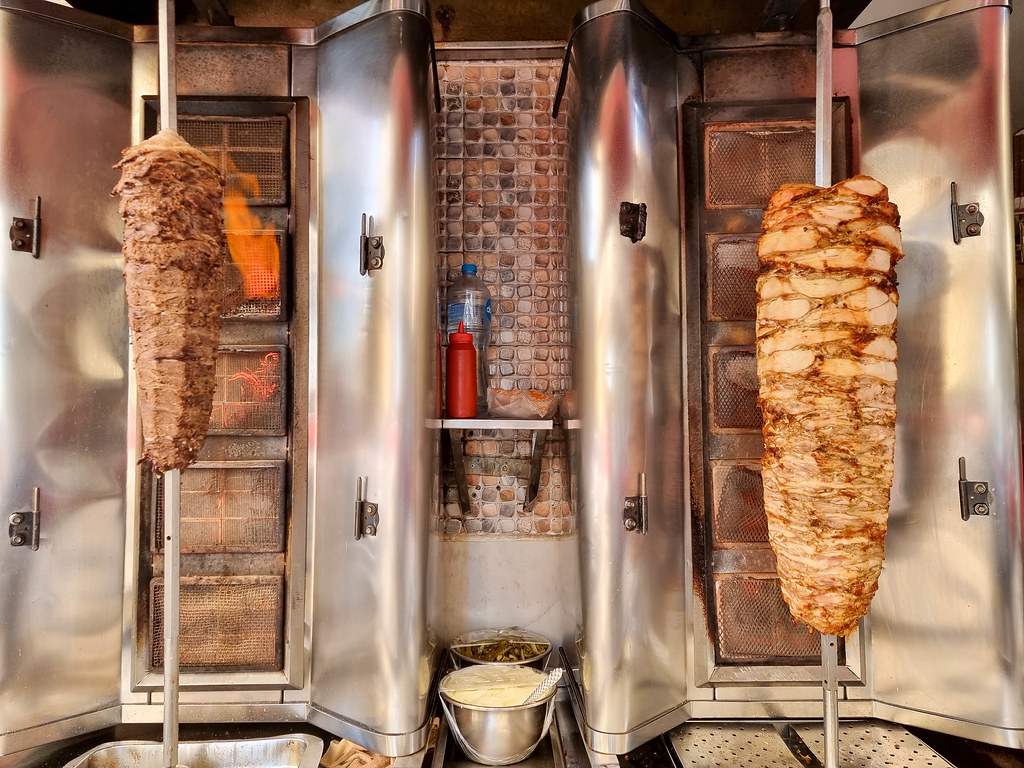
Egyptian food is relatively simple but extremely filling due to the high amount of carbs served which each meal. Most of the traditional Egyptian dishes focus on one main ingredient which is cooked with plenty of herbs and spices. Except for koshari, which is a mixture of everything.
If you are interested in learning more about the Egyptian food, consider taking a food tour or a cooking class in Cairo. Check out some options below:
- Dinner Cruise in Cairo with Belly Dance Show
- Cairo Food Tour with a Local
- Private Tour of the Citadel Follow By An Egyptian Cooking Class
Main Dishes
Many of the traditional Egyptian foods have their roots in Ancient Egypt. Tasting these Egyptian dishes is not just a delicious culinary experience, but also a trip back into history, thousands of years ago, when the land was cultivated with the same vegetables, pulses, and grains as today.
Koshari

Koshari is the national food of Egypt. It consists of a mixture of lentils, rice, chickpeas, pasta, fried onions, and lemon juice, served alongside a tomato chili sauce. On its own it’s quite bland, but once you add the tomato sauce, the dish comes to life.
The koshari has an interesting history in Egypt, originating sometime during the 19th century as “the food of the poor”. It is also believed that the dish has been influenced by the Coptic Christians who had a vegetarian diet when they were fasting for lent. The dish is full of carbs, and it is made to make you feel full, even if you eat a small portion.
Koshari is sold everywhere in Egypt, from street food stalls to luxury restaurants. Some restaurants specialise in koshari and that’s all they sell. Ordering koshari is easy, all you have to choose is the size and then decide whether or not you want the tomato sauce as well. I highly recommend you do.
Ful Medames

If koshari is the staple dish of the country, then ful medames is the traditional breakfast in Egypt. It consists of mashed fava beans mixed with oil, salt, and different spices as toppings.
It is not a good-looking dish, but it has so much flavour in it. It is usually served alongside warm Egyptian bread and, sometimes, falafels.
It is believed that ful medames has its origins in Ancient Egypt, as beans were a highly cultivated crop back then. Back in the Middle Ages, this dish used to be mostly found around the public bath in Cairo. After they closed the fires continued to burn, so the cooks would make the most of them and simmer giant pots filled with fava beans. By morning, the beans were cooked, and they were able to provide breakfast for the population of Cairo.
You can find ful medames everywhere, as a street food or for breakfast in your hotel’s restaurant.
Fattah

Fattah is a very important Egyptian food, usually eaten at major celebrations such as weddings, births or for Iftar during Ramadan. It consists of lamb or beef meat served on top of rice, alongside crispy bread and a vinegar or tomato sauce.
Even if it’s a special occasion dish, you will easily find Fattah in the restaurants around Cairo. I tried it at the café in the train station, whilst waiting for my train to Aswan.
Nubian Food

As soon as I arrived in Aswan, I was told that I have to try out the Nubian food, as it is different to the typical Egyptian dishes. I went to a restaurant in the Nubian village, but it was too busy, so instead I ended up having dinner with a local. The feast was cooked by his wife, who prepared five different dishes including roast chicken, Nubian tagine, fresh salad, and Egyptian bread.
I highly recommend you to have a local dinner experience in a Nubian village, when you visit Aswan. If you are not as lucky as I was to get invited by a local, you can always book a tour that will take you to a local’s house for dinner. Click here to check out this option.
Mulukhiyah
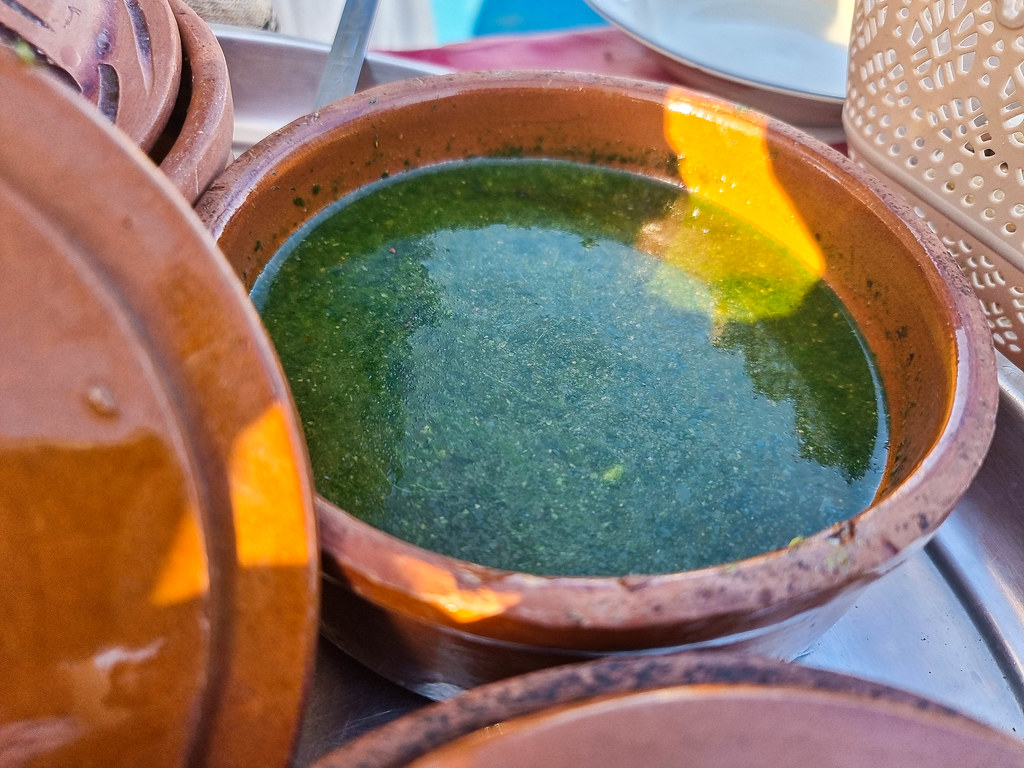
Mulukhiyahis one of those dishes that you either like or you don’t. It is made from jute leaves and has a rather slimy texture. It tastes bitter, but it is served with lemon to tame the flavour. Besides the green plant, Mulukhiyah also contains garlic and coriander. It is usually served alongside a piece of meat, such as roast chicken or lamb, and rice. In the coastal cities, Mulukhiyah is served with fish or seafood.
It is believed that Mulukhiyah is another dish that originated in the Ancient Egypt.
Mahsi

Another popular Egyptian food is Mahsi, also known as rice stuffed vegetables. Usually this dish contains vegetables such as bell peppers, aubergines, courgettes or tomatoes. The pulp is taken out and the inside is filled with a mixture of rice, seasoned with tomatoes, onions, and different herbs and spices. They are then put in a pot, covered with broth, and steamed for a few hours, until tender.
Mahsi is a very filling dish and a perfect choice for vegetarian travellers to Egypt.
Pigeon

Pigeon is a delicacy in Egypt. You will find restaurants that only serve stuffed pigeon. On the Nile cruise I took, we often had pigeon for lunch or dinner, labelled as chicken. It couldn’t have been chicken though as it was extremely small.
One of the most popular ways to eat pigeon in Egypt is stuffed with rice or wheat and herbs. The bird is boiled first until it’s cooked, then it’s grilled or roasted. The stuffing is quite aromatic, with plenty of herbs as well as cinnamon, nuts and cumin.
Fish Sayadiyah

Fish Sayadiyah is a popular Egyptian dish found alongside the coastal cities such as Alexandria. The name of the dish translates as fish with rice, seasoned with a spice mix called Baharat with includes an array of aromatic condiments.
The dish is usually served as a stew, with tomato sauce and onions. It is extremely flavoursome Egyptian food, and a must try.
Bamya
Bamya translates as okra stew. It can contain lamb, but most of the times I have had this dish, it was vegetarian. It’s a tasty dish, but I wasn’t very keen on the texture of the vegetable, which is quite slimy once it’s cooked.
Egyptian Mezze
In Egypt, mezze refers to the appetisers you order before your main meal. These small dishes are meant to be shared and the selection can include both hot and cold foods. Here are some of the typical dishes you will find on an Egyptian mezze platter.
Egyptian Bread
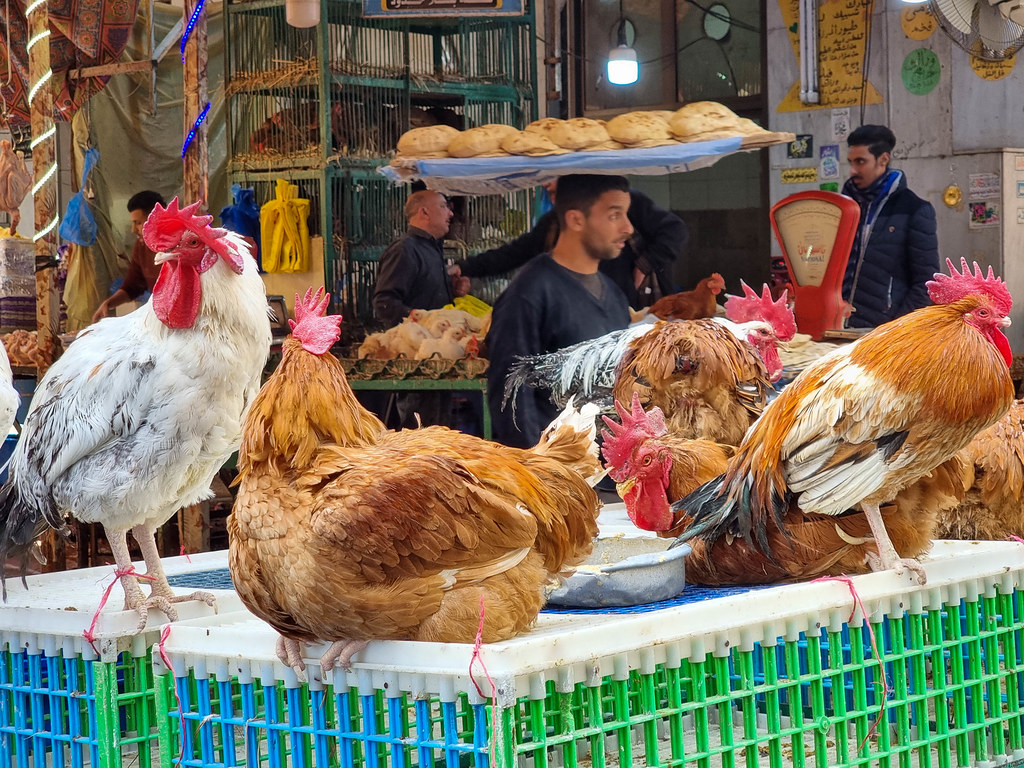
Bread is very important in Egypt. As an example, for breakfast on the cruise, we used to have at least ten different types of bread to choose from. The most famous Egyptian bread is the eish baladi, a fluffy flatbread baked from wheat flour. It has been consumed in Egypt since the Ancient times, when it used to be baked in red clay ovens made from the mud of River Nile.
To realise how important bread is in Egypt, the translation of “eish baladi” is “traditional life”.
The most authentic place to buy bread from is the market. Look for the men carrying the bread on giant flat baskets balanced on their heads.
Falafel – Ta’meya

Ta’meya is the Egyptian version of falafel. Whilst around the Middle East the falafel is made from chickpeas, in Egypt fava beans are used instead. Another difference is that in Egypt, the falafel are flat rather than having a round shape.
It is believed that the falafel originated in Egypt when the Coptic Christians looked for meat alternatives to eat during lent.
You will find falafel usually for breakfast. My hotel in Cairo served homemade green beans falafel on my first day in Egypt, and they were delicious.
Kibbeh

Kibbeh is similar with the falafel, but it is made with ground meat, and it is not vegetarian. The meat is mixed with spices and then stuffed with a mixture of bulgur, onions, and spices. It is then deep fried or baked. It is usually eaten with a dip of tahini or yogurt.
Baba Ghannoug

I don’t really like aubergines because of their mushy texture, but give me baba ghannoug and I would eat the entire bowl. Also known around the Middle East as baba ganoush, this dip is made from chopped grilled aubergines mixed with lemon juice, olive oil, cumin, parsley, salt, and pepper. Sometimes, tahini is added as well. I loved that the Egyptian baba gannoug didn’t have that overpowering cumin taste like its relative from Lebanon for example.
Egyptian Cheese – Gibna Beida

I was surprised to find out that cheese has its origins in the Middle East, and that it could be as long as 5,000 years ago. Traces of cheese have been found inside a tomb in Saqqarra, the necropolis of Memphis, the ancient capital of Egypt. It is thought that the alabaster jars filled with cheese were placed inside the tomb sometimes around 3,000BC.
Today, cheese is very popular in Egypt and served mostly with breakfast. I had it almost every day and couldn’t get enough of it. The white, salty cheese resembles feta, but it has a much creamier texture. It is made from buffalo or cow milk and tastes delicious. It is also known as Domiati cheese.
Tehina

It took me a good few days to try this sauce, as I wasn’t convinced by its watery texture. At first, I thought it may be a very loose hummus. Once I tried it out though, I went for it every time I ate meat. It’s a simple sauce made from tahini, lemon juice and garlic, that complements meat so well.
Egyptian Street Food
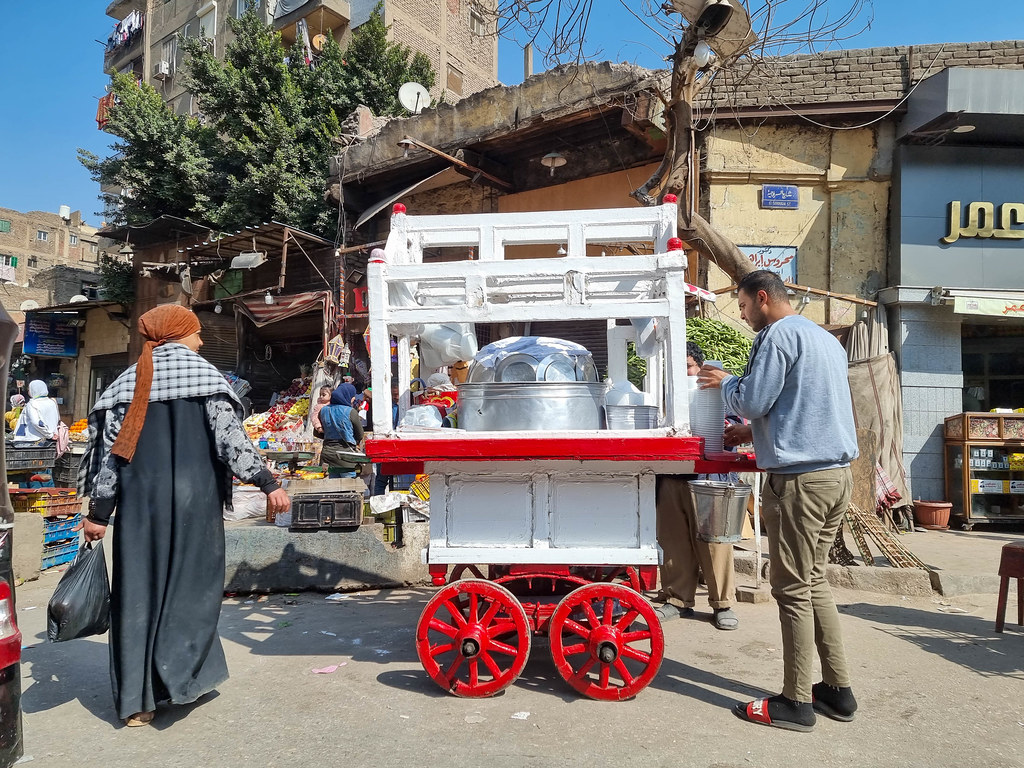
Street food is very popular in Egypt. And no wonder, as you can buy most of the traditional dishes in Egypt from street vendors. I have always said that street food is a big part of a country’s culture, so make sure you don’t overlook it when you visit Egypt. I had some amazing street food dishes, even if sometimes I didn’t really know what I was ordering.
Street Food Wraps

I ate quite a bit of street food during my 10 days in Egypt. This is because basing myself in a hotel near the Pyramids, meant that most of the restaurants around were overpriced and touristy. However, I did find a few holes in the wall selling different wraps. As I don’t know Arabic and the vendors didn’t speak much English, all I understood was “wraps”.
The wraps came with different fillings. My favourite was chicken, which was marinated and then cooked on a hot flat grill. It was then put inside a wrap, crisped up, and served with fries and tahini sauce. Delicious!
My only advice with street food, especially chicken, is to always make sure that the meat is cooked in front of you and it is piping hot when you receive it.
Shawarma
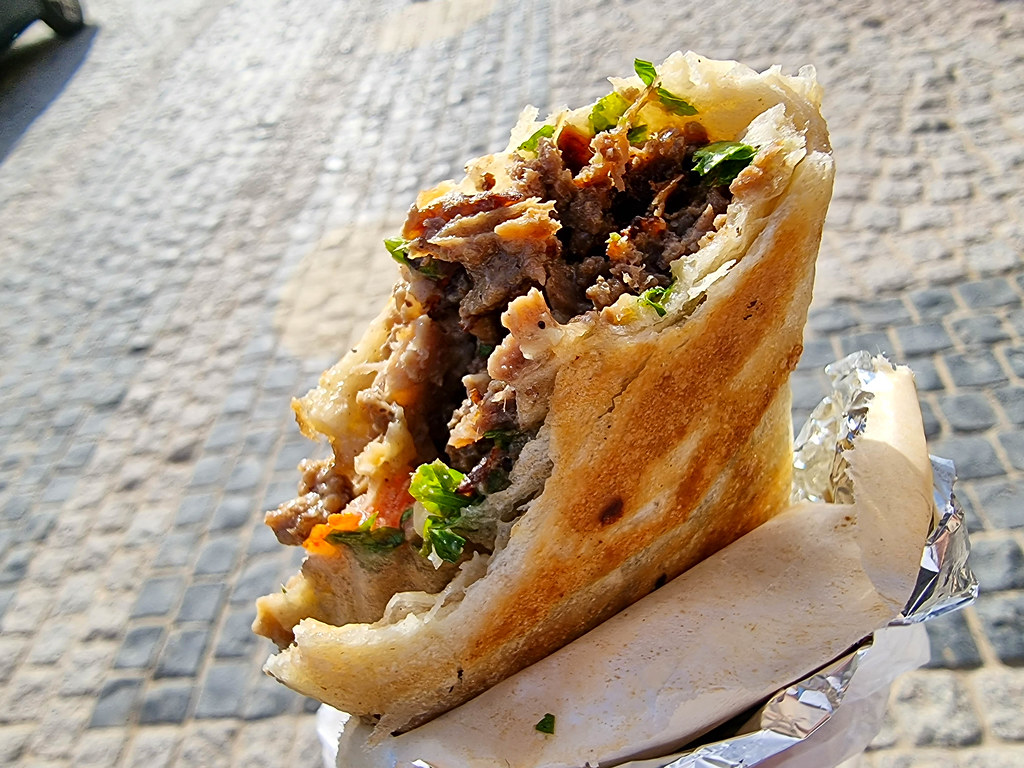
Growing up in Romania, Shawarma is one of my favourite street foods. Knowing how delicious it is in my home country, I was looking forward to trying out the Egyptian version.
Shawarma is a popular street food not just in Egypt but in many places around the Middle East and as far as Europe. Whilst the Shawarma I am used to was inspired by the Turkish kebab, it has quite a few similarities with the Egyptian version.
In Egypt, you can choose between chicken and beef for the protein in the wrap. I chose beef, as it’s safer than chicken when it comes to street food. The meat is grilled over a vertical rotating rotisserie, and then shaved thinly with a giant knife. The meat is put inside a flatbread, with greens, tomatoes, and tahini sauce. The flatbread is then rolled and pressed on the grill, to crisp up. The result is delicious!
Feseekh

Feseekh is a controversial Egyptian food that you will find mostly during the ancient Sham el-Nessim festival, which celebrates the beginning of the spring.
The dish consists of fermented, salted, and dried grey mullet. The fish is dried in the sun before being fermented in salt.
Kofta
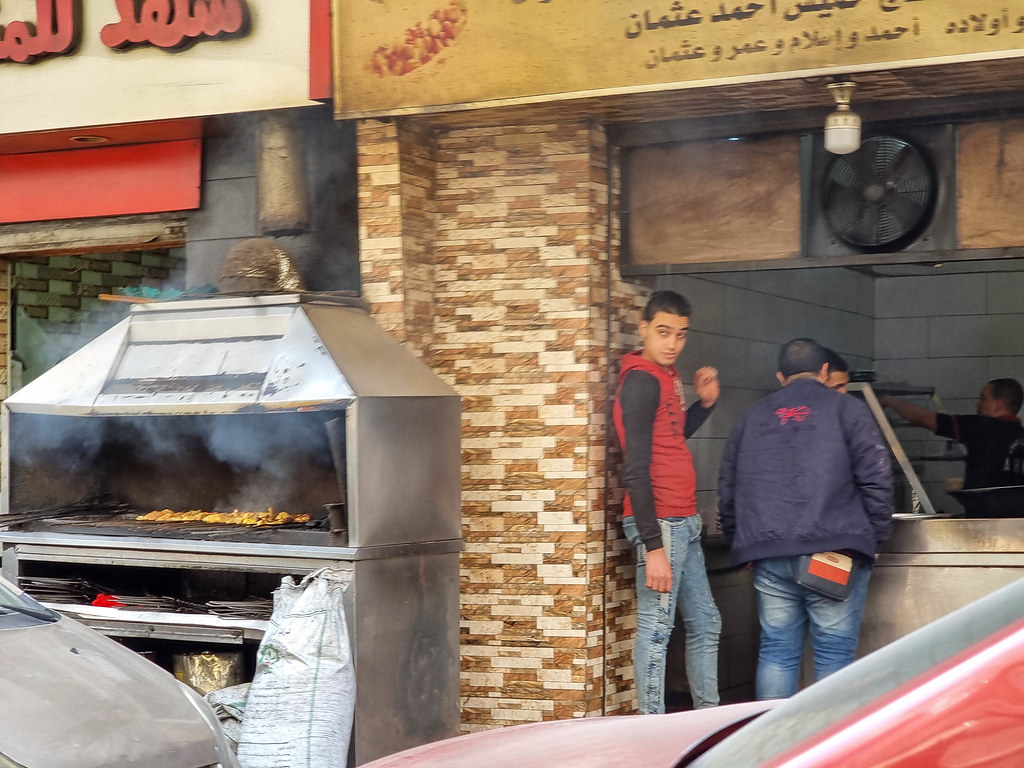
Kofta is another great street food that you must eat when you visit Egypt. You will see grills in the streets all over Cairo, with metal skewers holding a mixture of ground beef and lamb seasoned with onions, garlic, herbs, and spices.
Koftas are usually served with Egyptian bread, salad and different sauces.
Feteer
This Egyptian pie is another dish that has its origins in Ancient Egypt. Back then, it used to be an offering to the Gods. Today, it is a sign of hospitality, as locals will often offer it to welcome their guests.
Fateer is a layered pie with or without filling. The layers of dough are brushed with ghee and can be plain or filled with ground beef, cheese, chocolate spread, and even honey and jam.
Locals often refer to fateer as the Egyptian pizza due to the many different fillings it can have.
Hawawshi
Hawawshi is one of the newly created Egyptian foods, developed in 1971 by an Egyptian butcher. It is a savoury pie made from a pita bread filled with a mixture of minced meat and spices, and then baked in the oven.
Liver Sandwiches
If you visit Alexandria and don’t mind being adventurous, try out the liver sandwiches. The offal is chopped into small pieces and cooked together with peppers, garlic, chili, and cumin. To create the sandwich, the meat is put inside a baguette or bread roll and served with green chilies and lemon slices.
Baked Sweet Potatoes
Another popular street food, especially around Cairo, are the baked sweet potatoes. You can buy them from small carts, all over the city, mostly in winter. These carts bake sweet potatoes only, all day long.
Egyptian Desserts
When it comes to desserts, Egypt is not going to disappoint you. There are so many different types of baked pastries, cakes, cookies and puddings to try out, that you would need at least a month in the country to try them all. Here is a highlight of the most popular desserts in Egypt
Baklava
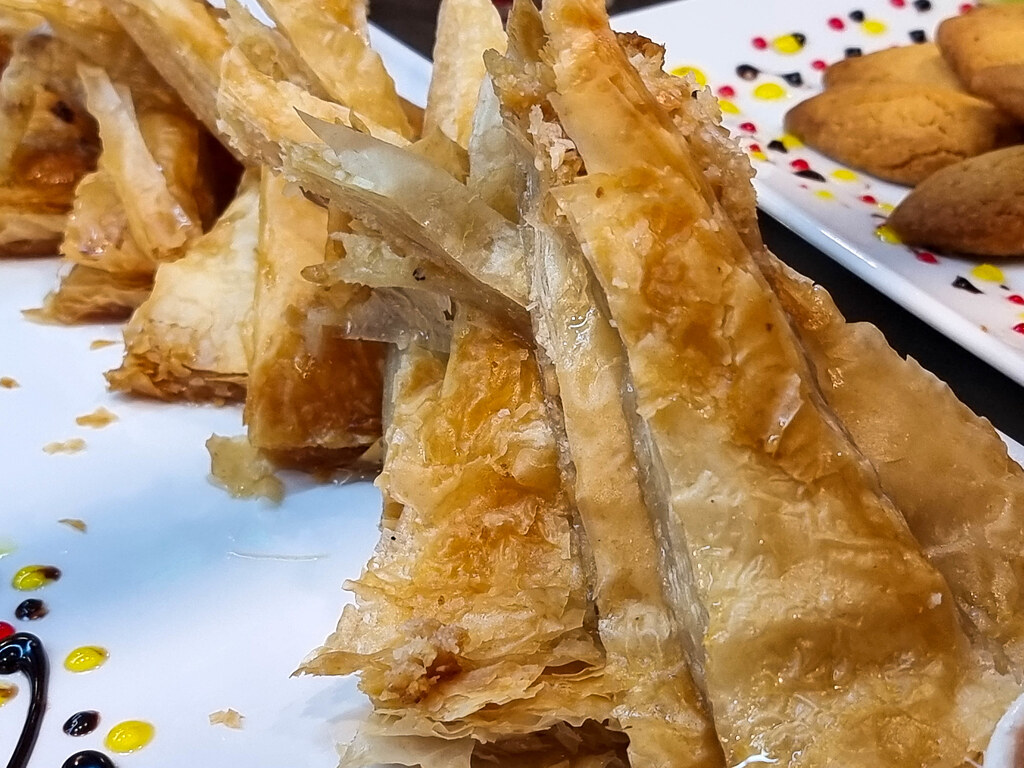
Baklava is a very popular dessert all over the Middle East, and I was expected to find it in Egypt as well. I was looking forward to tasting it, as I love authentic baklava. I really liked that the baklava in Egypt was less sweet than the one in Turkey, which I really enjoyed.
Baklava is a simple, but delicious dessert. It’s made with filo pastry layered with different nuts, pistachios in Egypt, soaked in sugar syrup.
Date Filled Biscuits
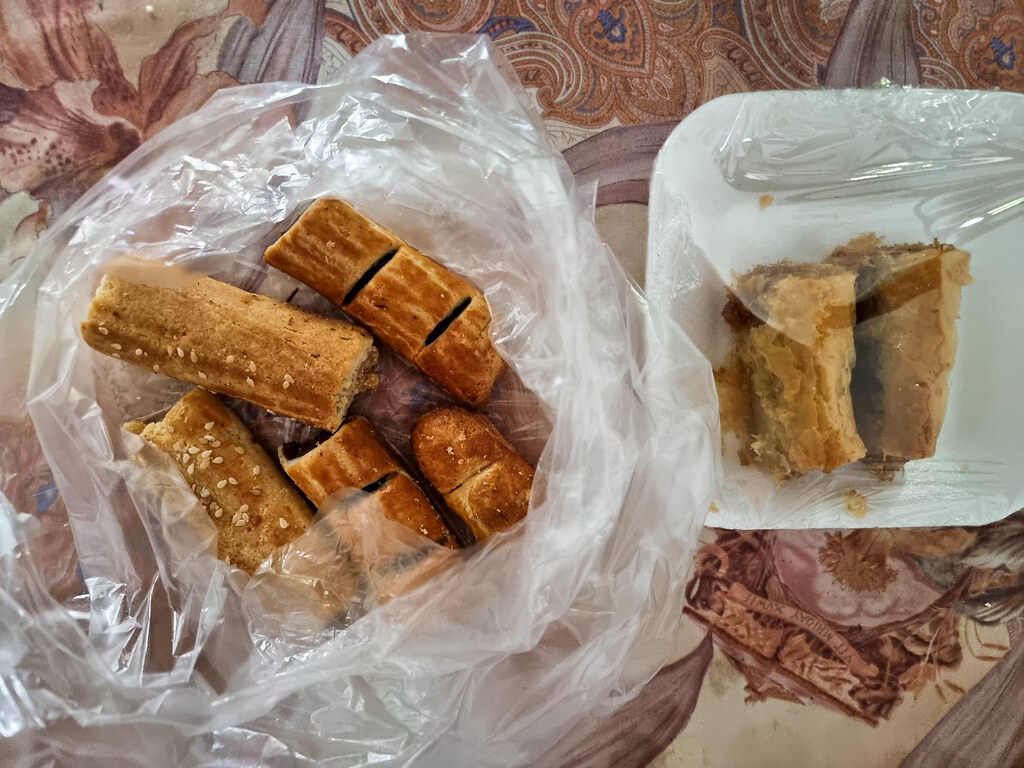
My hotel in Aswan was located near a bakery, so I picked up a few snacks for my long trip to Abu Simbel. Among them were some date filled biscuits, which were delicious.
Basbousa

This typical Egyptian desert is made from semolina and soaked in syrup. Sometimes it is topped with an almond. It is very sweet, but the portions are quite small.
Umm Ali

This is an Egyptian desert with a story. Back in the 13th century, to celebrate a victory of her husband the wife of Sultan Ezz El Din Aybak created this desert. Its name, “Umm Ali”, translates as “Ali’s mother”.
The desert is like a bread budding, made with puff pastry soaked in milk and layered with different things such as sugar, butter, raisins, nuts, and even coconut pieces.
Popular Egyptian Drinks
Hibiscus Tea
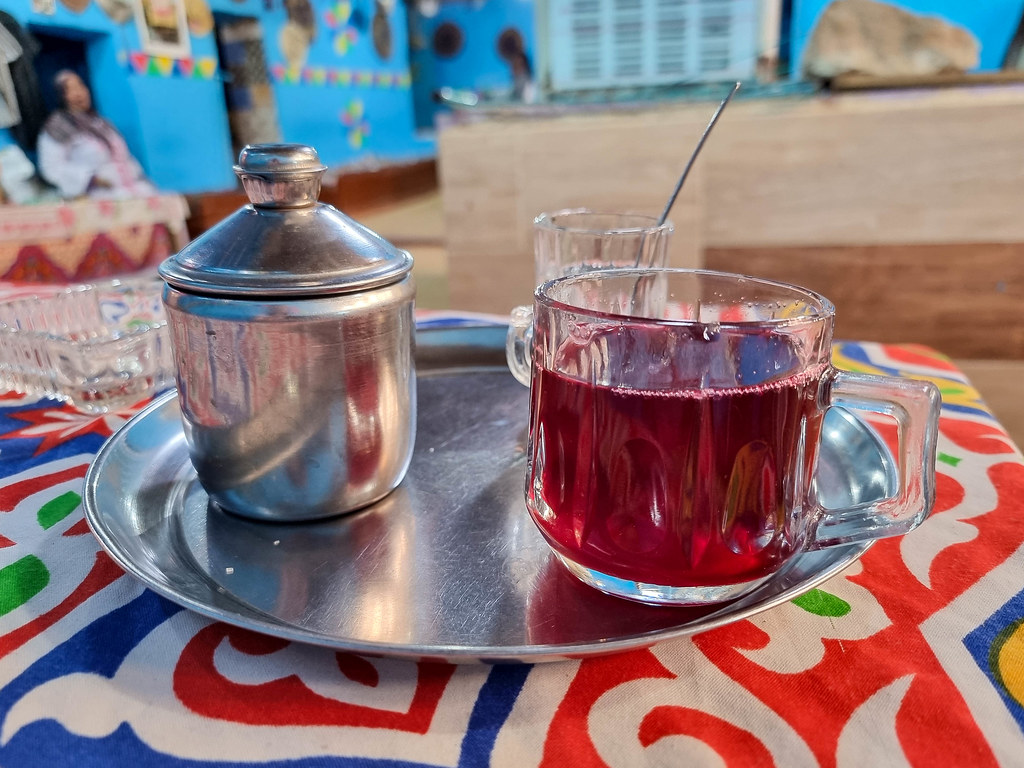
Without a doubt, the number one drink in Egypt is tea. The most popular ones are the classic black tea, the mint tea, and the hibiscus tea.
I really liked the hibiscus tea because of its versatility. It is extremely popular in the south, around Aswan, where you can buy the dried flowers in bulk, in the souk. You can drink hibiscus tea either hot, to warm yourself up, or cold to cool yourself down. When it’s cold and mixed with sugar, it transforms into a delicious juice.
Turkish Coffee

Turkish coffee, made over hot sand, is also very popular in Egypt. The best place to savour the coffee is in a traditional ahwa, an Egyptian coffee house. I enjoyed a cup of Turkish coffee in a lovely such coffee shop, in Alexandria.
Like it? Pin it!
Disclaimer: Some of the links on this website are “affiliate links.” This means that if you click on the link and do a purchase, I will receive an affiliate commission at no extra cost for you. This helps me keep my website running and continue to share my travelling knowledge with you. I thank you for booking your flights or hotels using the links on my website. Regardless, I only recommend products or services I use personally and believe will add value to my readers.






Well, now I am starving lol! Those are some really interesting-looking dishes and I cannot wait to try them soon. The part about finding cheese in a tomb in Saqqara is something I did not expect 🙂
Awesome article! I really enjoyed reading this – seeing and learning about the food in Egypt!
Being a vegan, I think it’s not bad there. I could easily try the Koshari and also Ful Madames. Thank you for listing down the food of Egypt so I can be ready with what to eat and what not. Tehina is my personal favourite though.
Being an Indian I love Egyptian food. There are a lot of similarities including spices and being vegetarian friendly as you mentioned. We too have a high amount of cards. Nubian food is so similar to a North Indian platter and the Ful Madames is similar to our Kichdi. I love it all!!!
Wow! This is interesting. Fattah looks delicious. Happy to know that you can easily find it in restaurants. Would love to try it.
I think I’ve only had 5 dishes on your list! 😀 I love my egyptian neighbors but we weren’t close enough to get me invited. 😀 I would also love to experience eating many on this list and cruise the Nile. Their kind of cheese intrigued me, I’ll definitely try it when I get the chance.
I haven’t been to Egypt yet, but I’d like to see it. I am a gourmand, and when traveling, I love to try local cuisine and spices, so I think I would feel great there. The wealth of spices, aromas, and flavors you present is vast. I would love to try Koshari, a lentil blend that I like. Ful medames, a traditional breakfast in Egypt, seems perfect to me. I also add to my list Mulukhiyahis and Mahsi. Your guide to Egyptian food is fantastic!
All of these dishes sound delicious. The Mahsi reminds me of Greek dishes where they stuff peppers with rice, orzo or cous cous. I never knew you could eat pidgeon! We have far to many, maybe that’s more sustainable than meats our country consume.
What an amazing array and selection of delicious food in Egypt, I feel like taking a flight there right now. The breads look so tasty and I dont mind trying pigeon meat as well